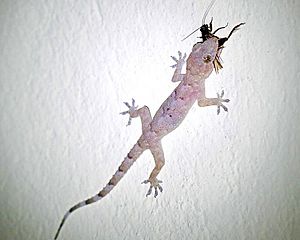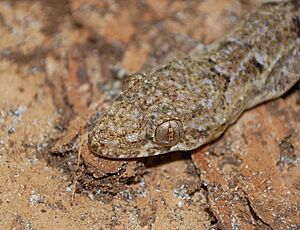Tropical house gecko facts for kids
Quick facts for kids Tropical house gecko |
|
|---|---|
 |
|
| Conservation status | |
| Scientific classification | |
| Synonyms | |
|

The tropical house gecko (Hemidactylus mabouia) is a type of house gecko. It is also known as the Afro-American house gecko or cosmopolitan house gecko. These geckos originally came from sub-Saharan Africa.
Today, you can find them in many places like North, Central, and South America, as well as the Caribbean. They arrived in these new places by accident, often carried by humans.
Contents
What Does a Tropical House Gecko Look Like?
These geckos can grow up to about 12.7 centimeters (5 inches) long, from their nose to the start of their tail. They have very large eyes, which help them see well in the dark. This is because they are active at night.
Tropical house geckos can slowly change their skin color. They can go from a light brown to a darker brown. This helps them blend in with their surroundings, making it harder for predators or prey to spot them.
What Do Tropical House Geckos Eat?
Tropical house geckos eat many different kinds of small creatures. Their diet includes isopods, centipedes, spiders, and scorpions. They also enjoy munching on cockroaches, beetles, moths, flies, and mosquitoes.
Sometimes, they even eat other small lizards like anoles or other geckos. Their favorite foods, however, are often Orthoptera species, which include insects like grasshoppers and crickets.
How Do Geckos Make Sounds?
Just like many other gecko species, the tropical house gecko can make sounds. Their calls can be very quiet, like soft peeps. They can also make quick, short squeaking noises.
You might hear these sounds most easily on a quiet night. If a gecko is sitting near an open window, its calls can be quite clear.
Where Do Tropical House Geckos Live?
Tropical house geckos mostly live in cities and towns. They are often found in places where people live, like houses and buildings. This is why they are called "house geckos."
How Do Geckos Behave?
Tropical house geckos are mostly nocturnal, meaning they are active at night. They are very good hunters of insects that fly or crawl in the dark.
They have learned a clever trick: they often wait near outdoor lights on walls. Insects are attracted to these lights, and the geckos can easily catch them there.
Geckos and People
In some parts of the Caribbean, people think it's good luck to have a tropical house gecko living in their home. These geckos are helpful because they eat many common household pests like mosquitoes and cockroaches.
Even though they are harmless, some people in Trinidad & Tobago used to believe that these geckos were a bad sign or had a poisonous touch. This is an old story, and it's not true. Tropical house geckos are not dangerous at all. In fact, they are quite helpful!
Images for kids
See also
 In Spanish: TUTEQUE para niños
In Spanish: TUTEQUE para niños



